How Do Great Danes Manage in Family Environments?
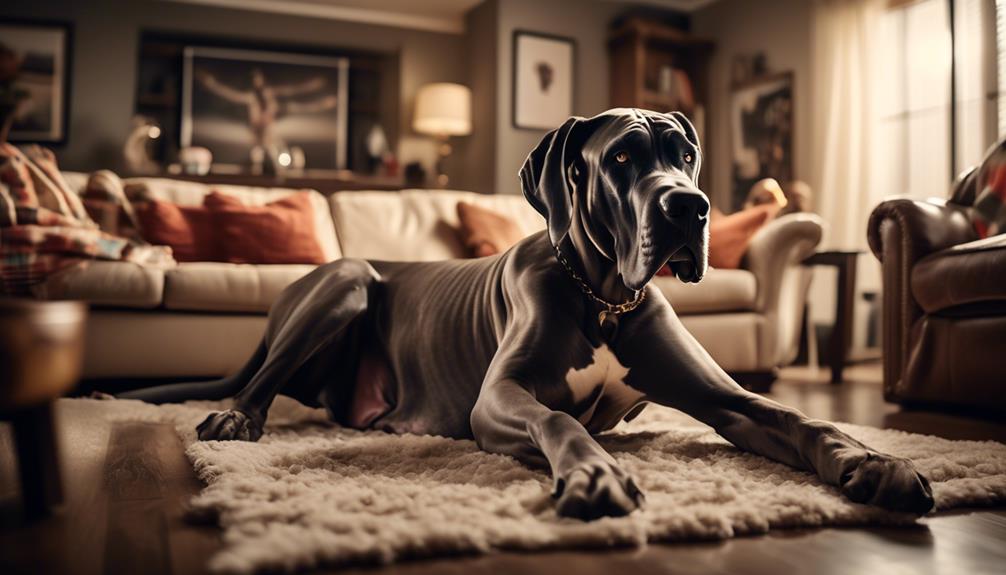
Great Danes manage well in family environments due to their adaptability, gentle temperament, and affectionate nature.
Their size, energy levels, behavior, and health concerns are also important factors to consider when integrating them into a family home.
Key Takeaways
- Great Danes have a gentle and easygoing nature, making them excellent companions for children and other pets.
- They can adapt well to living in homes with proper space and exercise opportunities, but early training and socialization are important.
- Managing the size of Great Danes in family homes requires establishing clear boundaries, providing ample space, incorporating regular exercise, and ensuring proper veterinary care and diet.
- Nurturing Great Dane behavior in a family setting involves early socialization, consistent and positive training methods, supervision of interactions with children, and providing ample exercise and mental stimulation.
Great Dane Adaptability in Families
Great Danes exhibit remarkable adaptability in family environments, thanks to their gentle and easygoing nature. This large breed, often referred to as gentle giants, has a reputation for being great family pets. Their friendly and patient disposition makes them excellent companions for children and other pets in the household.
Despite their size, Great Danes can adapt well to living in homes, as long as they've proper space and exercise opportunities. It's important to provide them with regular exercise to prevent obesity and to maintain their overall health. Great Danes may require early training and socialization to manage their size and strength in family settings. This will help them become well-behaved and obedient members of the household.
Proper care and attention to potential health issues are also crucial for the adaptability of Great Danes in families. Regular visits to the veterinarian, a nutritious diet, and grooming are essential to their well-being. It's important to be aware of potential health concerns such as hip dysplasia and bloat, which are common in this breed.
Managing Great Dane Size in Family Homes
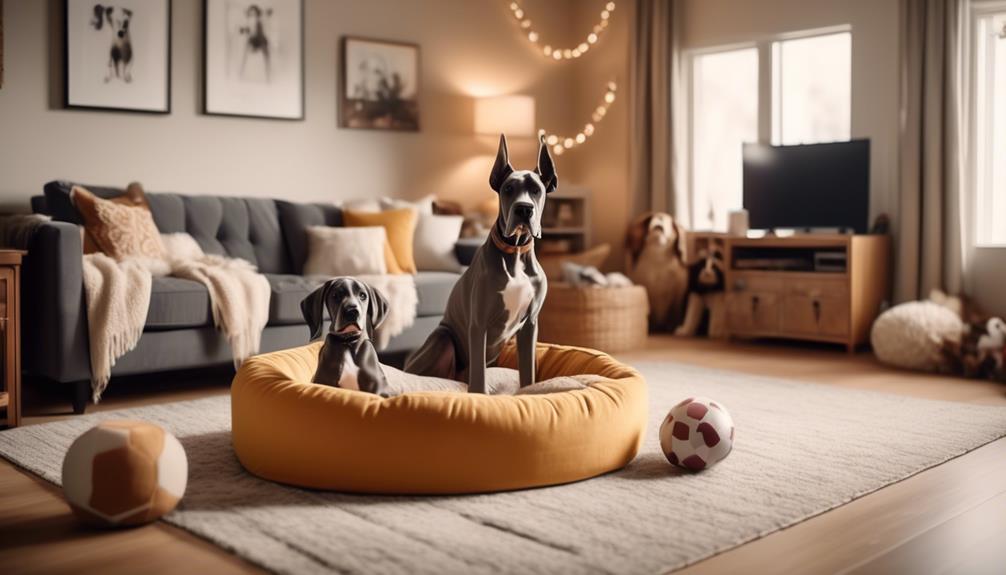
The adaptability of Great Danes in family environments extends to managing their size within the confines of a home, necessitating careful consideration and planning. Great Danes, known as gentle giants, are one of the largest dog breeds, often reaching heights of up to 32 inches and weighing between 110 and 175 pounds. Despite their imposing size, Great Danes can be excellent family pets when provided with proper training and socialization.
To effectively manage the size of Great Danes in family homes, it is crucial to establish clear boundaries and guidelines for their behavior. This can be achieved through positive reinforcement training methods, which encourage desired behaviors and discourage unwanted ones. Great Danes have a gentle nature and form strong bonds with their families, making them highly responsive to positive experiences with children.
In addition to training, providing ample space for the Great Dane to move around comfortably is essential. This includes both indoor and outdoor areas. Great Danes are not suitable for apartment living due to their large size and exercise requirements. Regular exercise routines should be incorporated to meet their physical needs and prevent boredom or restlessness.
It is important to note that Great Danes, like many large dog breeds, are prone to certain health issues such as hip dysplasia and bloat. Regular veterinary check-ups and a balanced diet can help mitigate these risks.
By considering the unique needs of Great Danes and implementing appropriate management strategies, families can enjoy the companionship of these gentle giants in a harmonious and fulfilling home environment.
| Management Strategies for Great Dane Size in Family Homes |
|---|
| 1. Establish clear boundaries and guidelines for behavior |
| 2. Use positive reinforcement training methods |
| 3. Provide ample space for the Great Dane to move around |
| 4. Incorporate regular exercise routines |
| 5. Ensure regular veterinary check-ups and a balanced diet |
Balancing Great Dane Energy and Exercise
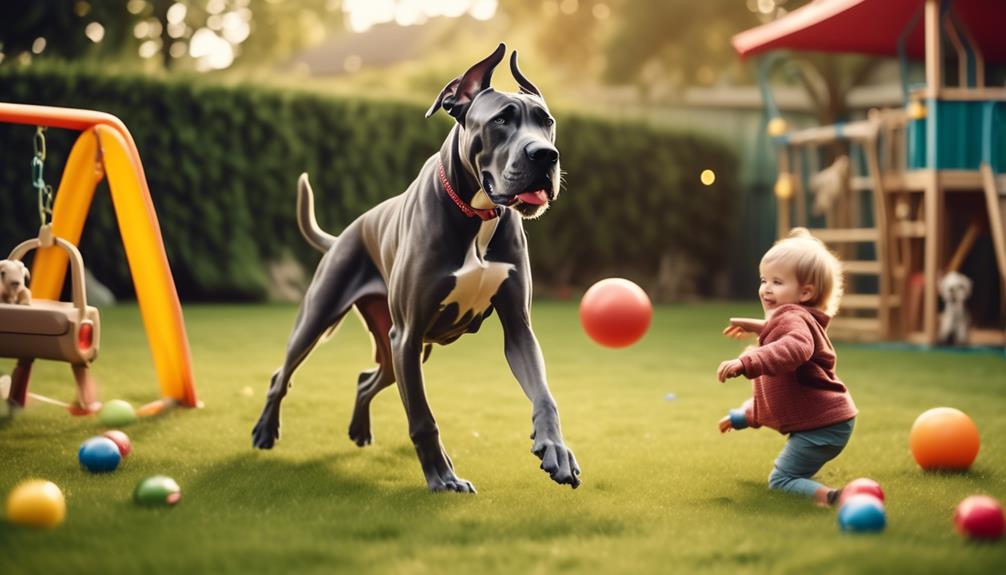
Balancing the energy and exercise needs of Great Danes is crucial for maintaining their health and well-being. Great Danes may be considered gentle giants, but they still require regular exercise to keep them physically and mentally fit. Here are some considerations for Great Dane owners when it comes to managing their energy and exercise:
- Supervise interactions: Great Danes are affectionate towards their family and can be protective. It's important to supervise their playtime with children and ensure that interactions are gentle and safe for everyone involved.
- Avoid leaving them alone for extended periods: Great Danes thrive on human companionship and can become anxious or destructive if left alone for long periods. They require proper care and attention, so make sure to spend quality time with them.
- Provide daily walks: Daily walks are essential for Great Danes to maintain their overall health. These walks should be firm and consistent, allowing them to stretch their legs and release their energy.
- Regular veterinary check-ups: Great Danes, like many large dog breeds, are prone to certain health problems such as hip dysplasia. Regular veterinary check-ups can help identify and address any potential issues early on.
Great Danes are known for their affectionate nature and make loving companions. By understanding their exercise needs and providing them with the proper care and attention, Great Dane owners can ensure their beloved pets live a healthy and fulfilling life.
Nurturing Great Dane Behavior in a Family Setting
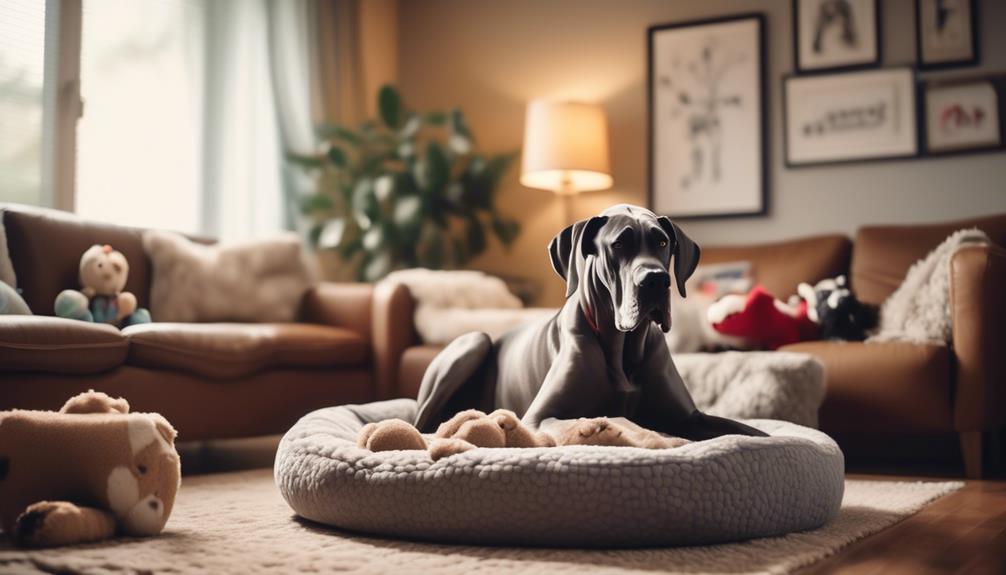
Nurturing appropriate behavior in Great Danes within a family setting requires consistent socialization and early training. Great Danes are gentle giants that thrive in family environments, but their large size and strength necessitate careful supervision when interacting with children. To help families understand how to nurture Great Dane behavior, the following table outlines key strategies:
| Strategies for Nurturing Great Dane Behavior in a Family Setting | |
|---|---|
| 1. Socialization | Begin socializing Great Danes at an early age, exposing them to various people, animals, and environments. This helps them develop positive associations and prevents shyness or aggression. |
| 2. Training | Implement consistent and positive training methods to establish boundaries, reinforce good behavior, and discourage unwanted behaviors such as jumping or pulling on the leash. |
| 3. Supervision | Always supervise interactions between Great Danes and children, particularly younger ones. While Great Danes are generally gentle, their size can unintentionally cause harm. |
| 4. Exercise and Mental Stimulation | Great Danes require ample exercise to prevent boredom and destructive behaviors. Regular walks, playtime, and engaging toys will help them release energy and maintain a balanced temperament. |
Coping With Great Dane Drooling and Slobbering
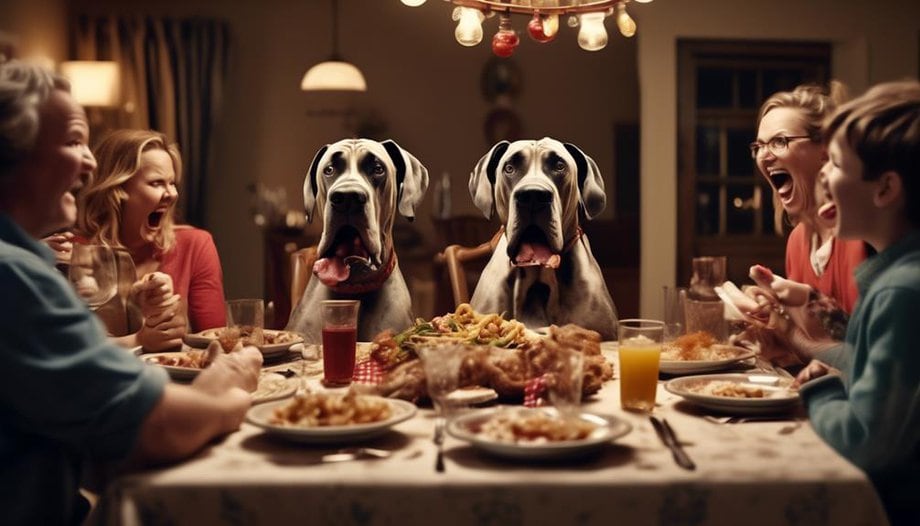
To effectively manage the excessive drooling and slobbering commonly seen in Great Danes, practical strategies can be implemented. Great Danes, with their large size and gentle giants demeanor, are known for their drooling and slobbering tendencies. Coping with this behavior is crucial, especially in family environments where interactions with children are frequent.
Here are some strategies to help cope with Great Dane drooling and slobbering:
- Keep a towel handy: Having a towel nearby and placing it under your Great Dane's mouth while eating or drinking can help manage drooling and slobbering. This simple step can minimize the mess and make cleanup easier.
- Provide access to fresh water: Dehydration can exacerbate excessive drooling in Great Danes. Ensuring that your Great Dane has constant access to fresh water can help reduce drooling and keep them hydrated.
- Regular dental care: Proper dental care, including regular teeth cleaning and check-ups, can significantly help manage and reduce drooling in Great Danes. Maintaining good oral hygiene can prevent dental issues that may contribute to excessive drooling.
Addressing Great Dane Health Concerns in Families
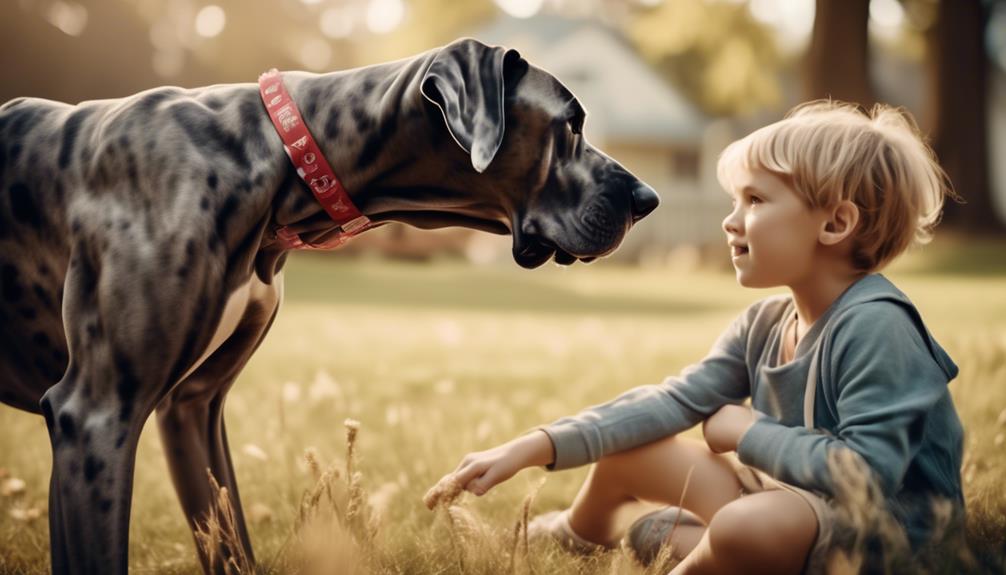
Great Dane health concerns in families can be effectively addressed through regular veterinary check-ups, a balanced diet, and proper exercise and grooming.
Great Danes, known as gentle giants, are prone to health issues due to their large size. Regular veterinary check-ups are essential to monitor their overall health and catch any potential problems early on.
A balanced diet is crucial to ensure that Great Danes receive the necessary nutrients and maintain a healthy weight, which is particularly important for their joints and heart health.
Proper exercise is also vital to keep Great Danes active and prevent obesity, which can exacerbate their susceptibility to health issues such as hip dysplasia.
Grooming plays a significant role in their care as well, as it helps maintain their coat and skin health.
In family environments, it's important to supervise interactions between Great Danes and children to prevent accidents or injuries. Providing ample exercise and mental stimulation for Great Danes is crucial to prevent behavioral issues that may arise from boredom or lack of stimulation.
Understanding Great Dane Protective Instincts in a Family Environment
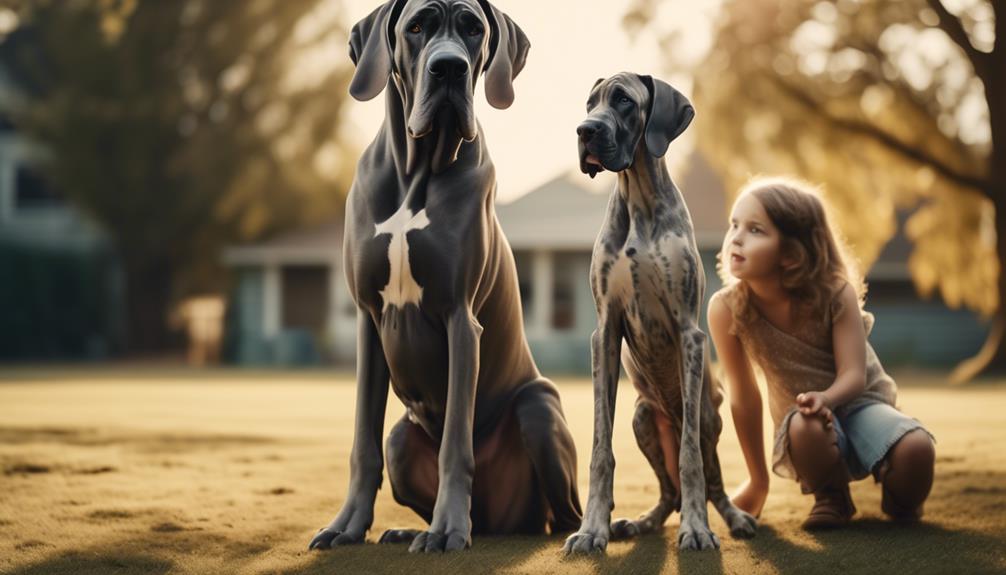
Regular veterinary check-ups, a balanced diet, and proper exercise and grooming are crucial in addressing Great Dane health concerns in families; however, it's equally important to understand their protective instincts in a family environment. Great Danes are known as gentle giants, but they've a natural protective instinct that can be triggered when they perceive a threat to their family members.
To better comprehend their protective instincts in a family setting, consider the following:
- Socialization and Training: Proper socialization and training are key in managing a Great Dane's protective instincts. Early exposure to various people, animals, and environments helps them differentiate between real threats and normal situations.
- Supervision with Children: Due to their large size and protective nature, it's important to supervise interactions between Great Danes and children. While they're generally gentle, their size alone can unintentionally cause harm to small children. Close monitoring ensures the safety of both the dog and the child.
- Ample Exercise and Mental Stimulation: Great Danes require ample exercise to maintain their overall well-being and manage their protective instincts. Sufficient physical activity helps channel their energy and prevents pent-up frustration. Engaging them in mental stimulation activities also helps keep their minds occupied.
Understanding and respecting the protective instincts of Great Danes in a family environment is crucial for everyone's safety and well-being. By providing proper socialization, supervision, and exercise, families can enjoy the loyal companionship of these gentle giants while ensuring the children's safety.
Frequently Asked Questions
Do Great Danes Make Good Family Dogs?
Great Danes make excellent family dogs due to their gentle nature and loyalty. They are patient with small children, but supervision is needed because of their size. Proper training, socialization, and exercise are essential for their well-being.
How Are Great Danes Around Kids?
Great Danes are playful companions and gentle giants with a kid-friendly temperament. Supervision and training are important when introducing them to children. Socialization with other kids can help build trust and bond. Growing up with Great Danes teaches responsibility and offers activities for kids.
What Are the Behavior Issues With Great Danes?
Great Danes may exhibit training challenges, separation anxiety, aggression tendencies, excessive barking, food aggression, destructive behavior, jumping on people, leash pulling, fearfulness, and dominance issues. Proper training and socialization are essential in managing these behavior issues.
At What Age Do Great Danes Settle Down?
Great Danes typically settle down around 2 to 3 years of age. This is influenced by factors such as socialization, training methods, balanced diet, exercise, and supervision. Early training and positive reinforcement contribute to their calm and gentle temperament.









